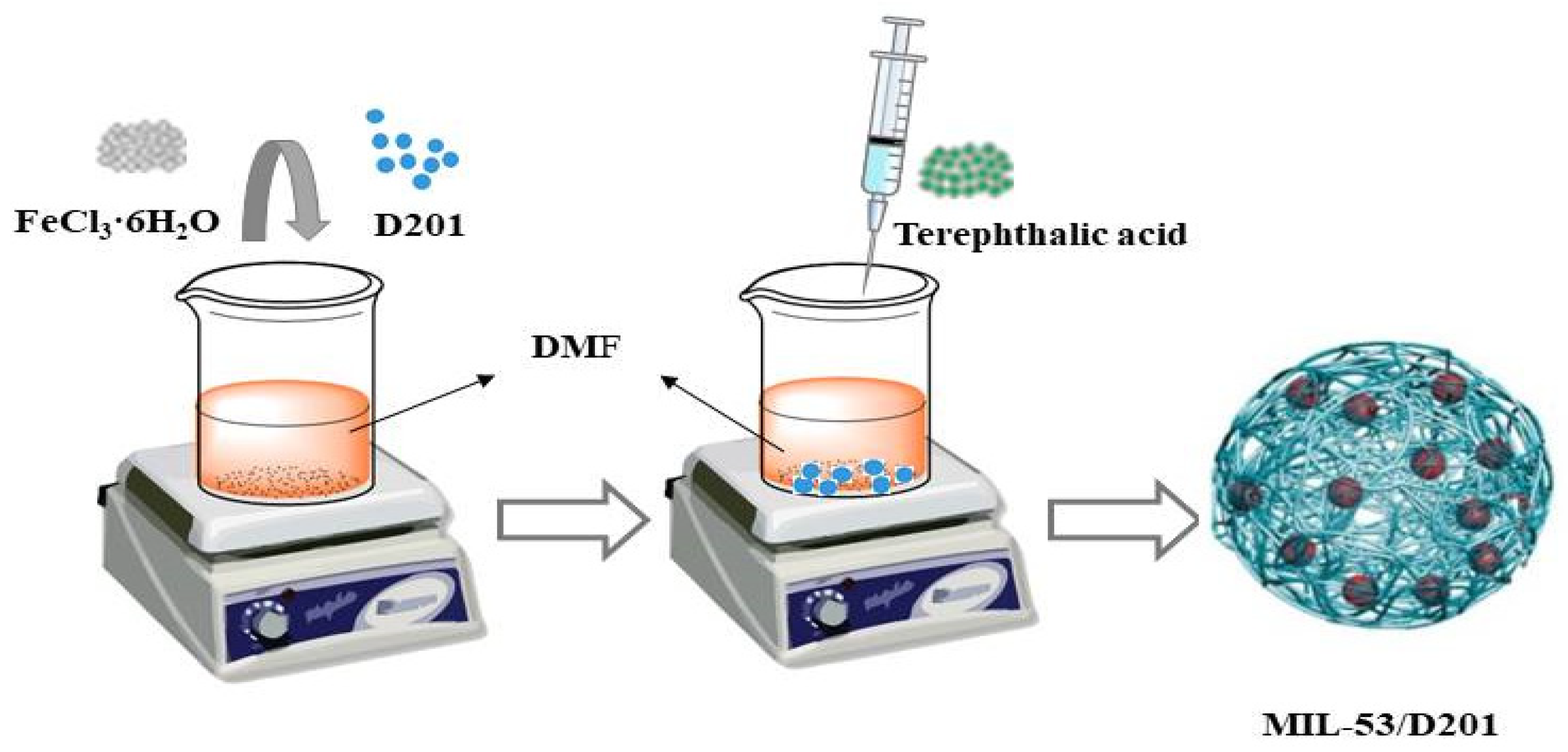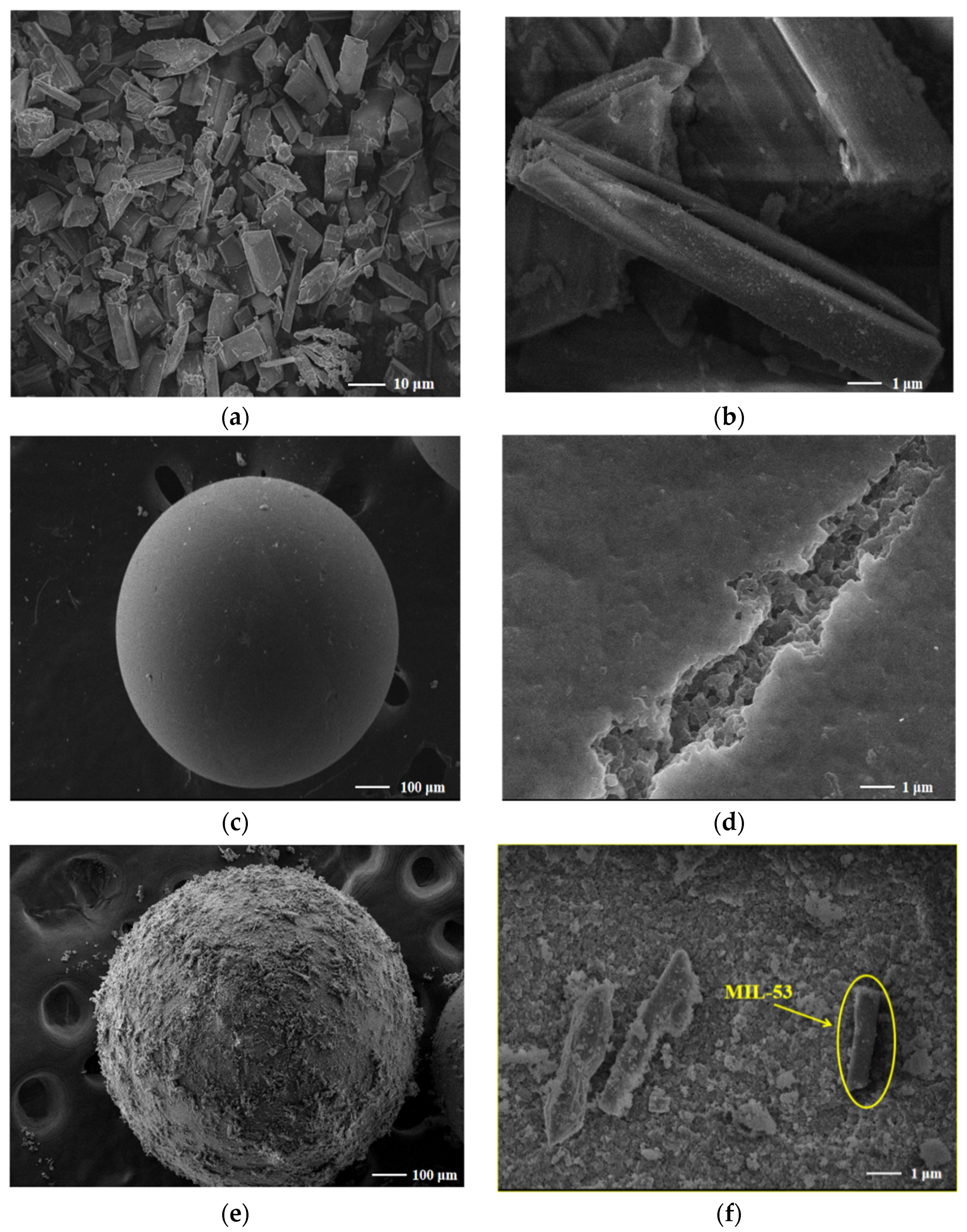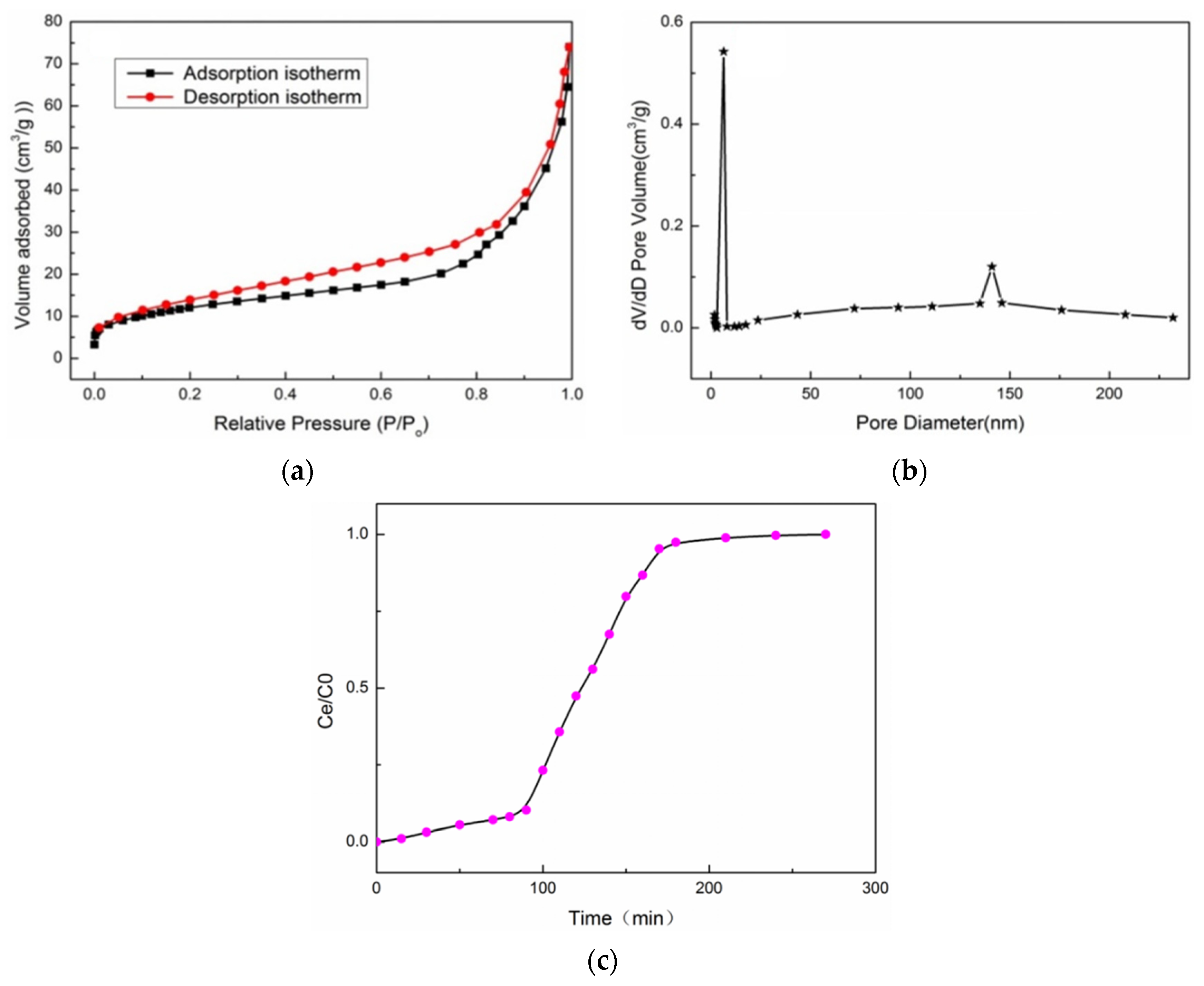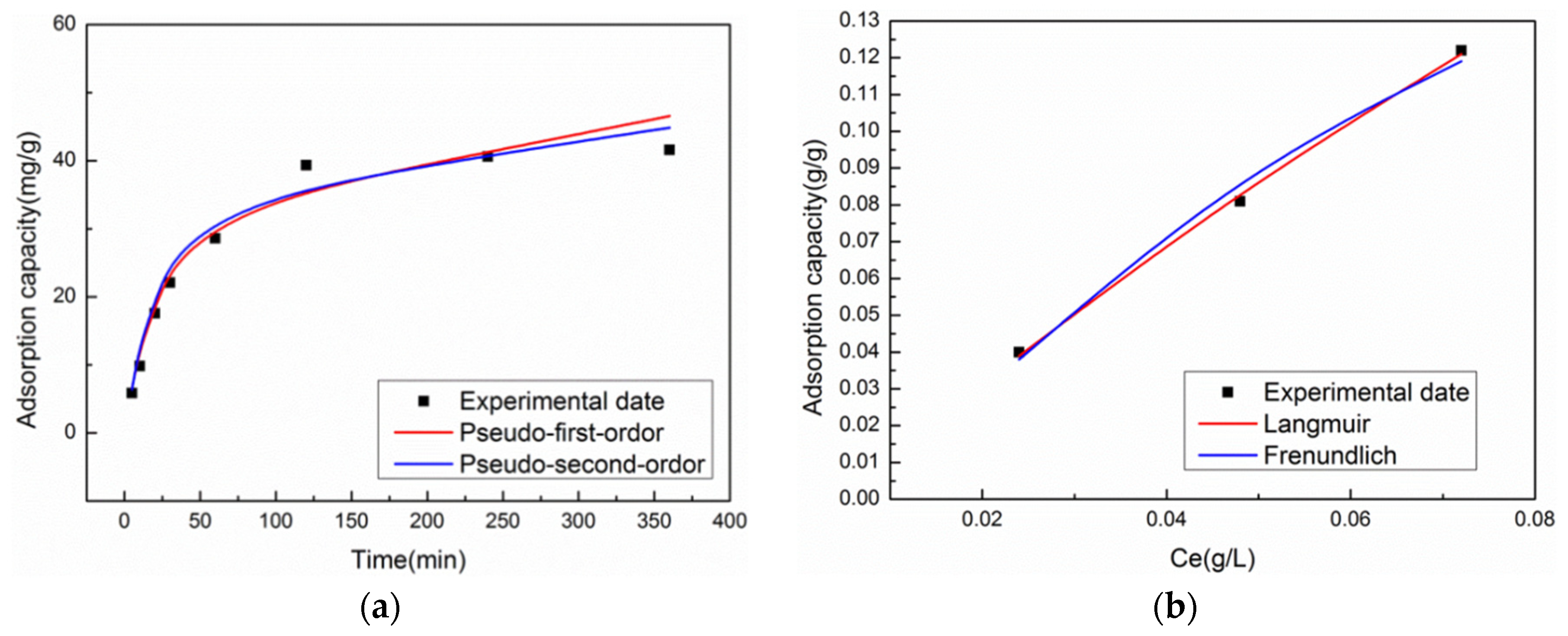Efficient Removal of Azlocillin Sodium from Water by Polystyrene Anion Exchange Resin Supported MIL-53
Abstract
:1. Introduction
2. Materials and Methods
2.1. Materials
2.2. Preparation of MIL-53/D201 Composite
2.3. Characterizations
2.4. Adsorption Experiment and Regeneration Experiment
3. Results and Discussions
3.1. Characterization
3.2. Penetration Curve
3.3. Effect of the Adsorbent Addition Amount
3.4. Effect of pH of the Solution
3.5. Effect of Interfering Ions in Solution
3.6. Adsorption Kinetics
3.7. Thermodynamics of Adsorption
3.8. Adsorption Regeneration
4. Conclusions
Author Contributions
Funding
Institutional Review Board Statement
Informed Consent Statement
Data Availability Statement
Acknowledgments
Conflicts of Interest
References
- Xie, H.; Du, J.; Chen, J. Concerted Efforts Are Needed to Control and Mitigate Antibiotic Pollution in Coastal Waters of China. Antibiotics 2020, 9, 88. [Google Scholar] [CrossRef] [Green Version]
- Li, J.; Wang, X.; Zhao, G.; Chen, C.; Chai, Z.; Alsaedi, A.; Hayat, T.; Wang, X. Metal-organic framework-based materials: Superior adsorbents for the capture of toxic and radioactive metal ions. Chem. Soc. Rev. 2018, 47, 2322–2356. [Google Scholar] [CrossRef] [PubMed]
- Bobbitt, N.S.; Mendonca, M.L.; Howarth, A.J.; Islamoglu, T.; Hupp, J.T.; Farha, O.K.; Snurr, R.Q. Metal-organic frameworks for the removal of toxic industrial chemicals and chemical warfare agents. Chem. Soc. Rev. 2017, 46, 3357–3385. [Google Scholar] [CrossRef] [PubMed]
- Mon, M.; Bruno, R.; Ferrando-Soria, J.; Armentano, D.; Pardo, E. Metal-organic framework technologies for water remediation: Towards a sustainable ecosystem. J. Mater. Chem. A 2018, 6, 4912–4947. [Google Scholar] [CrossRef]
- Hasan, Z.; Jhung, S.H. Removal of hazardous organics from water using metal-organic frameworks (MOFs): Plausible mechanisms for selective adsorptions. J. Hazard. Mater. 2015, 283, 329–339. [Google Scholar] [CrossRef] [PubMed]
- Martínez, J.L. Antibiotics and antibiotic resistance genes in natural environments. Science 2008, 321, 365–367. [Google Scholar] [CrossRef] [PubMed]
- Gaikwad, S.; Cheedarala, R.K.; Gaikwad, R.; Kim, S.; Han, S. Controllable Synthesis of 1,3,5-tris (1H-benzo [d] imidazole-2-yl) Benzene-Based MOFs. J. Appl. Sci. 2021, 11, 9856. [Google Scholar] [CrossRef]
- Howarth, A.J.; Liu, Y.; Hupp, J.T.; Farha, O.K. Metal-organic frameworks for applications in remediation of oxyanion/cation-contaminated water. CrystEngComm 2015, 17, 7245–7253. [Google Scholar] [CrossRef]
- Zou, Y.; Wang, X.; Khan, A.; Wang, P.; Liu, Y.; Alsaedi, A.; Hayat, T.; Wang, X. Environmental remediation and application of nanoscale zero-valent iron and its composites for the removal of heavy metal ions: A review. Environ. Sci. Technol. 2016, 50, 7290–7304. [Google Scholar] [CrossRef]
- Wu, X.; Tan, X.; Yang, S.; Wang, P.; Liu, Y.; Alsaedi, A.; Hayat, T.; Wang, X. Coexistence of adsorption and coagulation processes of both arsenate and NOM from contaminated groundwater by nanocrystallined Mg/Al layered double hydroxides. Water Res. 2013, 47, 4159–4168. [Google Scholar] [CrossRef] [PubMed]
- Hadi, P.; To, M.H.; Hui, C.W.; Lin, C.S.K.; McKay, G. Aqueous mercury adsorption by activated carbons. Water Res. 2015, 73, 37–55. [Google Scholar] [CrossRef]
- Hoskins, B.F.; Robson, R. Infinite polymeric frameworks consisting of three dimensionally linked rod-like segments. J. Am. Chem. Soc. 1989, 111, 5962–5964. [Google Scholar] [CrossRef]
- Colinas, I.R.; Silva, R.C.; Oliver, S.R.J. Reversible, selective trapping of perchlorate from water in record capacity by a cationic metal-organic framework. Environ. Sci. Technol. 2016, 50, 1949–1954. [Google Scholar] [CrossRef]
- Zhu, L.; Xiao, C.; Dai, X.; Li, J.; Gui, D.; Sheng, D.; Chen, L.; Zhou, R.; Chai, Z.; Albrecht-Schmitt, T.E.; et al. Exceptional perrhenate/pertechnetate uptake and subsequent immobilization by a low-dimensional cationic coordination polymer: Overcoming the hofmeister bias selectivity. Environ. Sci. Technol. Lett. 2017, 4, 316–322. [Google Scholar] [CrossRef]
- Bhadra, B.N.; Seo, P.W.; Khan, N.A.; Jhung, S.H. Hydrophobic cobalt-ethylimidazolate frameworks: Phase-pure syntheses and possible application in cleaning of contaminated water. Inorg. Chem. 2016, 55, 11362–11371. [Google Scholar] [CrossRef] [PubMed]
- Farha, O.K.; Eryazici, I.; Jeong, N.C.; Hauser, B.G.; Wilmer, C.E.; Sarjeant, A.A.; Snurr, R.Q.; Nguyen, S.T.; Yazaydin, A.O.; Hupp, J.T. Metal-organic framework materials with ultrahigh surface areas: Is the sky the limit? J. Am. Chem. Soc. 2012, 134, 15016–15021. [Google Scholar] [CrossRef] [Green Version]
- Alaerts, L.; Maes, M.; Giebeler, L.; Jacobs, P.A.; Martens, J.A.; Denayer, J.F.; Kirschhock, C.E.; De Vos, D.E. Selective Adsorption and Separation of Ortho-Substituted Alkylaromatics with the Microporous Aluminum Terephthalate MIL-53. J. Am. Chem. Soc. 2008, 130, 14170–14178. [Google Scholar] [CrossRef] [PubMed]
- Gwon, K.; Han, I.; Lee, S.; Kim, Y.; Lee, D.N. Novel metal–organic framework-based photocrosslinked hydrogel system for efficient antibacterial applications. ACS Appl. Mater. Interfaces 2020, 12, 20234–20242. [Google Scholar] [CrossRef]
- Gwon, K.; Kim, Y.; Cho, H.; Lee, S.; Yang, S.H.; Kim, S.J.; Lee, D.N. Robust Copper Metal–Organic Framework-Embedded Polysiloxanes for Biomedical Applications: Its Antibacterial Effects on MRSA and In Vitro Cytotoxicity. Nanomaterials 2021, 11, 719. [Google Scholar] [CrossRef] [PubMed]
- Ma, X.; Wang, W.; Sun, C.; Li, H.; Sun, J.; Liu, X. Adsorption performance and kinetic study of hierarchical porous Fe-based MOFs for toluene removal. Sci. Total Environ. 2021, 793, 148622. [Google Scholar] [CrossRef] [PubMed]
- Shen, K.; Zhang, L.; Chen, X.; Liu, L.; Zhang, D.; Han, Y.; Chen, J.; Long, J.; Luque, R.; Li, Y.; et al. Ordered macro-microporous metal-organic framework single crystals. Science 2018, 359, 206–210. [Google Scholar] [CrossRef] [Green Version]
- Ou, R.; Zhang, H.; Wei, J.; Kim, S.; Wan, L.; Nguyen, N.S.; Hu, Y.; Zhang, X.; Simon, G.P.; Wang, H. Thermoresponsive amphoteric metal-organic frameworks for efficient and reversible adsorption of multiple salts from water. Adv. Mater. 2018, 30, 1802767. [Google Scholar] [CrossRef] [PubMed]
- Valizadeh, B.; Nguyen, T.N.; Smit, B.; Stylianou, K.C. Porous Metal-Organic Framework@ Polymer Beads for Iodine Capture and Recovery Using a Gas-Sparged Column. Adv. Funct. Mater. 2018, 28, 1801596. [Google Scholar] [CrossRef]
- McHugh, L.N.; McPherson, M.J.; McCormick, L.J.; Morris, S.A.; Wheatley, P.S.; Teat, S.J.; McKay, D.; Dawson, D.M.; Sansome, C.E.F.; Ashbrook, S.E.; et al. Hydrolytic stability in hemilabile metal-organic frameworks. Nat. Chem. 2018, 10, 1096–1102. [Google Scholar] [CrossRef] [Green Version]
- Hynek, J.; Brázda, P.; Rohlíček, J.; Londesborough, M.G.; Demel, J. Phosphinic acid based linkers: Building blocks in metal-organic framework chemistry. Angew. Chem. Int. Ed. 2018, 57, 5016–5019. [Google Scholar] [CrossRef]
- Yuan, S.; Feng, L.; Wang, K.; Pang, J.; Bosch, M.; Lollar, C.; Sun, Y.; Qin, J.; Yang, X.; Zhang, P.; et al. Stable metal-organic frameworks: Design, synthesis, and applications. Adv. Mater. 2018, 30, 1704303. [Google Scholar] [CrossRef] [Green Version]
- Liang, R.; Jing, F.; Shen, L.; Qin, N.; Wu, L. MIL-53(Fe) as a highly efficient bifunctional photocatalyst for the simultaneous reduction of Cr(VI) and oxidation of dyes. J. Hazard. Mater. 2015, 287, 364–372. [Google Scholar] [CrossRef]
- Du, J.; Yuan, Y.; Su, J.; Peng, F.; Jiang, X.; Qiu, L.; Xie, A.; Shen, Y.; Zhu, J. New photocatalysts based on MIL-53 metal-organic frameworks for the decolorization of methylene blue dye. J. Hazard. Mater. 2011, 190, 945–951. [Google Scholar] [CrossRef] [PubMed]
- Zhu, B.J.; Yu, X.Y.; Jia, Y.; Peng, F.M.; Sun, B.; Zhang, M.Y.; Lou, T.; Liu, J.H.; Huang, X.J. Iron and 1, 3, 5-benzenetricarboxylic metal-organic coordination polymers prepared by solvothermal method and their application in efficient As (V) removal from aqueous solutions. J. Phys. Chem. C 2012, 116, 8601–8607. [Google Scholar] [CrossRef]
- Molinari, A.; Varani, G.; Polo, E.; Vaccari, S.; Maldotti, A. Photocatalytic and catalytic activity of heterogenized W10O324—In the bromide-assisted bromination of arenes and alkenes in the presence of oxygen. Mol. Catal. A Chem. 2007, 262, 156–163. [Google Scholar] [CrossRef]
- Zhang, X.; Cheng, C.; Qian, J.; Lu, Z.; Pan, S.; Pan, B. Highly efficient water decontamination by using sub-10 nm FeOOH confined within millimeter-sized mesoporous polystyrene beads. Environ. Sci. Technol. 2017, 51, 9210–9218. [Google Scholar] [CrossRef]
- Zhang, X.; Wu, M.; Dong, H.; Li, H.; Pan, B. Simultaneous oxidation and sequestration of As (III) from water by using redox polymer-based Fe (III) oxide nanocomposite. Environ. Sci. Technol. 2017, 51, 6326–6334. [Google Scholar] [CrossRef] [PubMed]
- Liu, F.; Shan, C.; Zhang, X.; Zhang, Y.; Zhang, W.; Pan, B. Enhanced removal of EDTA-chelated Cu (II) by polymeric anion-exchanger supported nanoscale zero-valent iron. J. Hazard. Mater. 2017, 321, 290–298. [Google Scholar] [CrossRef]
- Araya, T.; Jia, M.; Yang, J.; Zhao, P.; Cai, K.; Ma, W.; Huang, Y. Resin modified MIL-53 (Fe) MOF for improvement of photocatalytic performance. J. Appl. Catal. B Environ. 2017, 203, 768–777. [Google Scholar] [CrossRef]
- Ai, L.; Zhang, C.; Li, L.; Jiang, J. Iron terephthalate metal-organic framework: Revealing the effective activation of hydrogen peroxide for the degradation of organic dye under visible light irradiation. Appl. Catal. B Environ. 2014, 148, 191–200. [Google Scholar] [CrossRef]
- Gao, Y.; Li, S.; Li, Y.; Yao, L.; Zhang, H. Accelerated photocatalytic degradation of organic pollutant over metal-organic framework MIL-53 (Fe) under visible LED light mediated by persulfate. Appl. Catal. B Environ. 2017, 202, 165–174. [Google Scholar] [CrossRef]
- Huang, W.; Liu, N.; Zhang, X.; Wu, M.; Tang, L. Metal organic framework g-C3N4/MIL-53 (Fe) heterojunctions with enhanced photocatalytic activity for Cr (VI) reduction under visible light. Appl. Surf. Sci. 2017, 425, 107–116. [Google Scholar] [CrossRef]
- Zhang, N.; Yuan, L.Y.; Guo, W.L.; Luo, S.Z.; Chai, Z.F.; Shi, W.Q. Extending the use of highly porous and functionalized MOFs to Th (IV) capture. ACS Appl. Mater. Interfaces 2017, 9, 25216–25224. [Google Scholar] [CrossRef]
- Yao, M.; Dong, Y.; Feng, X.; Hu, X.; Jia, A.; Xie, G.; Hu, G.; Lu, J.; Luo, M.; Fan, M. The effect of post-processing conditions on aminosilane functionalizaiton of mesocellular silica foam for post-combustion CO2 capture. Fuel 2014, 123, 66–72. [Google Scholar] [CrossRef]
- Wan, D.; Ma, X.; Sentorun-Shalaby, C.; Song, C. Development of carbon-based “molecular basket” sorbent for CO2 capture. Ind. Eng. Chem. Res. 2012, 51, 3048–3057. [Google Scholar]
- Haque, E.; Jun, J.W.; Jhung, S.H. Adsorptive removal of methyl orange and methylene blue from aqueous solution with a metal-organic framework material, iron terephthalate (MOF-235). J. Hazard. Mater. 2011, 185, 507–551. [Google Scholar] [CrossRef]
- Bandura, L.; Kołodyńska, D.; Franus, W. Adsorption of BTX from aqueous solutions by Na-P1 zeolite obtained from fly ash. Process Saf. Environ. Prot. 2017, 109, 214–223. [Google Scholar] [CrossRef]










| Adsorbate (0.1 mmol/L) | Penetration Time (min) | Saturation Time (min) |
|---|---|---|
| Azlocillin sodium | 40 | 165 |
| R2 | K | |
|---|---|---|
| Pseudo-first-order | 0.942 | 0.254 |
| Pseudo-second-order | 0.957 | 0.084 |
| Langmuir | 0.993 | 2.056 |
| Freundlich | 0.987 | 0.182 |
Publisher’s Note: MDPI stays neutral with regard to jurisdictional claims in published maps and institutional affiliations. |
© 2021 by the authors. Licensee MDPI, Basel, Switzerland. This article is an open access article distributed under the terms and conditions of the Creative Commons Attribution (CC BY) license (https://creativecommons.org/licenses/by/4.0/).
Share and Cite
Qian, Y.; Fu, H.; Li, L.; Su, W.; Li, J.; Zhang, Y. Efficient Removal of Azlocillin Sodium from Water by Polystyrene Anion Exchange Resin Supported MIL-53. Processes 2021, 9, 2195. https://doi.org/10.3390/pr9122195
Qian Y, Fu H, Li L, Su W, Li J, Zhang Y. Efficient Removal of Azlocillin Sodium from Water by Polystyrene Anion Exchange Resin Supported MIL-53. Processes. 2021; 9(12):2195. https://doi.org/10.3390/pr9122195
Chicago/Turabian StyleQian, Yi, Haoyan Fu, Long Li, Wenyuan Su, Jiayin Li, and Yihao Zhang. 2021. "Efficient Removal of Azlocillin Sodium from Water by Polystyrene Anion Exchange Resin Supported MIL-53" Processes 9, no. 12: 2195. https://doi.org/10.3390/pr9122195
APA StyleQian, Y., Fu, H., Li, L., Su, W., Li, J., & Zhang, Y. (2021). Efficient Removal of Azlocillin Sodium from Water by Polystyrene Anion Exchange Resin Supported MIL-53. Processes, 9(12), 2195. https://doi.org/10.3390/pr9122195





